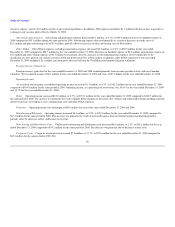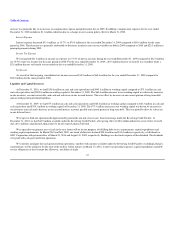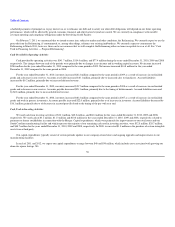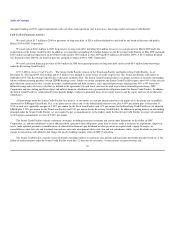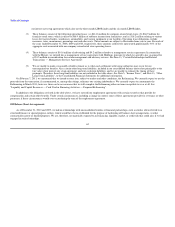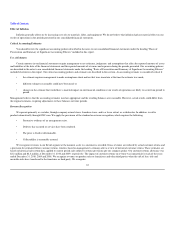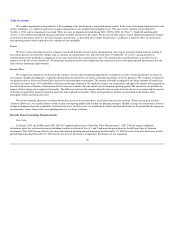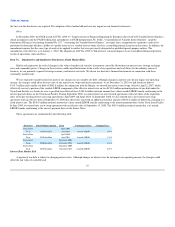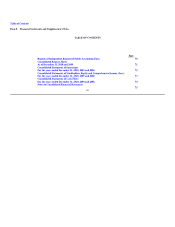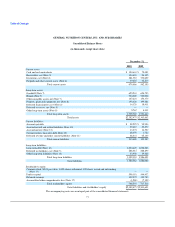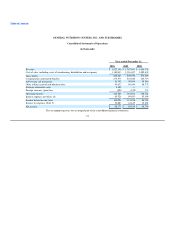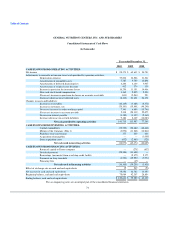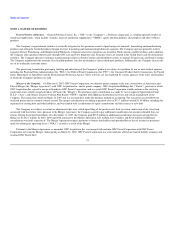GNC 2011 Annual Report Download - page 70
Download and view the complete annual report
Please find page 70 of the 2011 GNC annual report below. You can navigate through the pages in the report by either clicking on the pages listed below, or by using the keyword search tool below to find specific information within the annual report.
Table of Contents
We conduct impairment testing annually at the beginning of the fourth quarter, using third quarter results. In the event of declining financial results and
market conditions, we could be required to recognize impairments to our goodwill and intangible assets. The most recent valuation was performed at
October 1, 2010, and no impairment was found. There was also no impairment found during 2010, 2009 or 2008. See Note 7, "Goodwill and Intangible
Assets", to our audited consolidated financial statements included elsewhere in this report. We do not currently expect to incur additional impairment charges
in the foreseeable future; however, the risks relating to our business, as described above under "Risk Factors", could have a negative effect on our business
and operating results which could affect the valuation of our intangibles.
Leases
We have various operating leases for company owned and franchise store locations and equipment. Store leases generally include amounts relating to
base rental, percent rent and other charges such as common area maintenance fees and real estate taxes. Periodically, we receive varying amounts of
reimbursements from landlords to compensate us for costs incurred in the construction of stores. We amortize these reimbursements as an offset to rent
expense over the life of the related lease. We determine the period used for the straight-line rent expense for leases with option periods and conform it to the
term used for amortizing improvements.
Income Taxes
We compute our annual tax rate based on the statutory tax rates and tax planning opportunities available to us in the various jurisdictions in which we
earn income. Significant judgment is required in determining our annual tax rate and in evaluating uncertainty in our tax positions. We recognize a benefit for
tax positions that we believe will more likely than not be sustained upon examination. The amount of benefit recognized is the largest amount of benefit that
we believe has more than a 50% probability of being realized upon settlement. We regularly monitor our tax positions and adjust the amount of recognized tax
benefit based on our evaluation of information that has become available since the end of our last financial reporting period. The annual tax rate includes the
impact of these changes in recognized tax benefits. The difference between the amount of benefit taken or expected to be taken in a tax return and the amount
of benefit recognized for financial reporting represents unrecognized tax benefits. These unrecognized tax benefits are presented in the balance sheet
principally within accrued income taxes.
We record valuation allowances to reduce deferred tax assets to the amount that is more likely than not to be realized. When assessing the need for
valuation allowances, we consider future taxable income and ongoing prudent and feasible tax planning strategies. Should a change in circumstances lead to a
change in judgment about the realizability of deferred tax assets in future years, we would adjust related valuation allowances in the period that the change in
circumstances occurs, along with a corresponding increase or charge to income.
Recently Issued Accounting Pronouncements
Fair Value
In January 2010, the FASB issued ASU 2010-06 "Improving Disclosures about Fair Value Measurements". ASU 2010-06 requires additional
disclosures about fair value measurements including transfers in and out of Levels 1 and 2 and more disaggregation for the different types of financial
instruments. This ASU became effective for annual and interim reporting periods beginning after December 15, 2009 for most of the new disclosures and for
periods beginning after December 15, 2010 for the new Level 3 disclosures. Comparative disclosures are not required in
66


